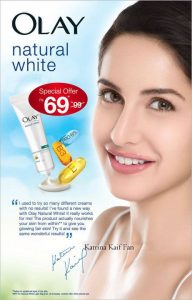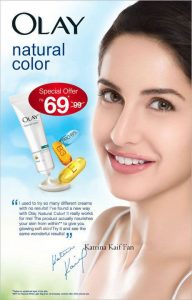Original Version:

This is an old Olay ad marketed towards the Indian demographic, branding the promise of fair, white skin.
Colorism in India has always been a major issue. This has stemmed from the fact that past invaders that have entered and colonized India were generally light-skinned, from the Mughals and lastly to the British. The British who had fair skin were seen as the superior and intelligent race whilst the Indians were to be ruled over as they were deemed inferior. The British also further influenced the caste system, giving lighter skinned Indians more preference, such as jobs, signifying their value compared to their darker skinned counterparts (Mishra 2015). The ripples from this past has shaped modern India, the British colonization has greatly left a lasting impact, one of them being the idealization of the eurocentric beauty standards being a symbol of wealth, intelligence and lastly beauty.
This has particularly been an issue for young women, as many are discriminated for their darker complexion for major things such as jobs or even marriage. India’s film industry, Bollywood, adhere to this standard as most actors are not only fair-skinned and also have very euro-centric features. This criteria especially applies to women, such as Katrina Kaif, the actress and model of this ad, who has half Indian. So not only does the mainstream media adhere to the western beauty ideals, we now have a product that advertises the promise of this beauty, of “whiter” skin.
The issue with this ad is the fact that Olay advertising skin whitening creams further targets this insecurity faced by many women. It inevitably perpetuates this stigma that darker complexions equate to undesirability while fairness equates to superiority and beauty. These ads also always include lighter skinned women with mainly eurocentric features. This unrealistic, unattainable western standard of beauty that many young women seek in order to feel more beautiful. Fairness creams are generally a marketing scam that target this insecurity and they never really do work. So morally, this is all false advertising.
Jammed Version:

In my jammed version, my first reconstruction was to address the main issue of this ad. The title, I believe, is the main source of the problem. The product name being “natural white” is problematic as for sales, it is targeting a demographic group that for years have been structured to see fair skin as the epitome of beauty. I wanted to say that beauty comes in all colors and therefore I changed the title from “natural white” to “natural color.” I replaced this in every area you see the product name, from the smallest places to even the testimony. By doing this, I also wanted to enforce that the meaning of “natural” refers to all skin colors, not just white. I also changed one of the lines from the testimony from “fair skin” to “soft skin” as I believe the main concern for any cream brand should not be to idealize the thought of fairness but rather advertise for making skin healthy, soft and glow no matter what skin tone.
Olay is just one of many brands that, when advertising products in the Indian subcontinent, have used promising words such as “fairness” or “white” in their creams. Loreal, Nivea, Ponds and even India’s own Fair & Lovely have been guilty of this. I believe it should also be a moral responsibility for companies to advertise honestly and not promote products promising whiteness, even if may not be the best business practice. By doing this perhaps we can one day destroy the mainstream beauty standards that plagues the Indian subcontinent, the belief of fairness equating to beauty, and rather embrace that beauty comes in all skin colors.
References:
Mishra, N. 2015. India and Colorism: The Finer Nuances. Washington University Global Studies Law Review
Link: https://openscholarship.wustl.edu/cgi/viewcontent.cgi?article=1553&context=law_globalstudies